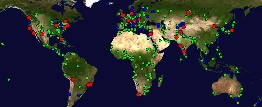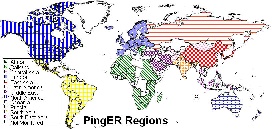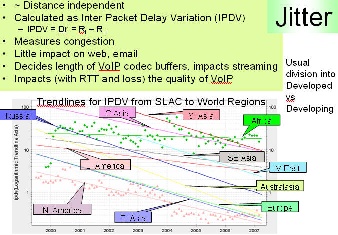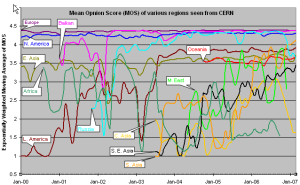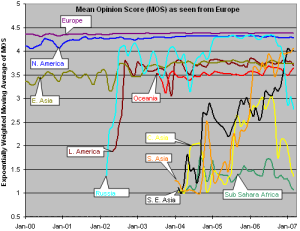Pinger Coverage
|
|
PingER Coverage Worldwide |
PingER Regions |
|---|
The figure - Eastern Asia - depicts the countries considered to be part of East Asia. These are China, Japan, North Korea, South Korea, Mongolia and Taiwan. The map - PingER coverage of Eastern Asia highlights the Monitoring (Red), Beacon (Blue) and Remote (green) sites in Eastern Asia. The distribution of these nodes is shown in Table - 1 below.
Table - 1 - Node Distribution in Eastern Asia
|
Monitoring |
Beacon |
Remote |
|---|---|---|---|
Japan |
2 |
0 |
17 |
China |
1 |
0 |
6 (east) |
South Korea |
1 |
0 |
5 |
Mongolia |
0 |
1 |
0 |
Taiwan |
1 |
1 |
1 |
North Korea |
0 |
0 |
0 |
Worldwide Comparison
|
|
|
|
Packet Loss as seen from N. America |
min RTT as seen from N. America |
Unreachability |
Jitter |
|---|
The left hand figure shows the packet loss to various regions of the world as seen from N. America. Since losses are fairly distance independent no attempt has been made to normalize the data. It is seen that the world divides up into two major super-regions: N. America, Europe, E. Asia and Oceania (mainly Australia and New Zealand) with losses below 0.1%, and Latin America, C. Asia, Russia, S.E. Asia, S. Asia and Africa with losses > 0.1% and as high as as a few per-cent. All countries are improving exponentially, but Africa is falling further behind most regions.
The second figure from the left shows the drop in the Minimum RTT from 2002-2006. The large step for S. Asia in 2003 was due to the change over from satellite to fibre. Central Asia (also Afghanistan) has hardly moved in its minimum RTT since it continues to use geostationary satellites.
The third figure from the left shows the unreachability of world regions seen from the US. A host is deemed unreachable if all pings of a set fail to respond. It shows the fragility of the link and is mainly distance independent (the reasons for fragility are usually in the last mile, the end site or host). Again the developed regions - US and Canada, E. Asia, and Oceania - have the lowest unreachability (< 0.3%) while the other regions vary from 0.7% to 2%. Africa shows poor statistics and is not improving, where as S. Asia has the second worst results.
The last graph shows the jitter (or variability of RTT) of world regions seen from the US. The jitter is defined as the Inter Quartile Range (IQR) of the Inter Packet Delay Variability (IPDV i = RTT i - RTT i-1). Jitter is relatively distance independent, it measures congestion, and has little impact on the Web and email. It decides the length of VoIP codec buffers and impacts streaming. We see the usual division into developed versus developing regions.
MOS for various Regions
There are three factors that significantly impact call quality: latency, packet loss, and jitter. We calculate the jitter using the Inter Packet Delay Variability (IPDV) , see the tutorial for further details.
Most tool-based solutions calculate what is called an "R" value and then apply a formula to convert that to an MOS score. Then the R to MOS calculation is relatively standard. The R value score is from 0 to 100, where a higher number is better. To convert latency, loss, and jitter to MOS we follow Nessoft's method. The graphs below shows the Exponentially Weighted Moving Average (using EWMI i = alpha * EWMI i-1 + (1 - alpha) * Obs i where alpha = 0.7 and EWMI 1 = Obs 1) for the MOS as seen from the W. Coast of America (SLAC) and Switzerland (CERN). N.B. MOS values of one are reported for heavy loss (loss > 40 %).
|
|
|
Mean Opinion Score as seen from the US |
Mean Opinion Score as seen from CERN |
Mean Opinion Score as seen from Europe |
|---|
CERN monitors fewer remote hosts than SLAC (56 versus over 400) so the data is not as complete in the CERN case. Comparing the two graphs, it can be seen that, as expected, the MOS is better for the shorter distances (i.e. CERN to Europe is better than SLAC to Europe, SLAC to N. America is better than CERN to N. America.).
It is also seen in both graphs that the Balkans, Russia and Latin America improved dramatically in 2000-2002. Much of Latin America and Russia moved from satellite to land lines in this period. It can be seen from the above plot that VoIP ought to be successful between SLAC and the US, Europe, E. Asia, Russia, Latin America and the Mid East (all above MOS = 3.5). S. E. Asia is marginal, S. Asia people will have to be very tolerant of one another, and C. Asia and Africa are pretty much out of the question in general. In general the CERN graphs looks similar to the SLAC graph to the various regions, except that S. E. Asia is worse for CERN than SLAC as is S. Asia
The third graph shows the Mean Opinion Score (MOS) from Europe two various regions. We have five monitoring sites in Europe (one at CERN, one at ICTP, one in Germany, and two at UK. The improvement in Latin America and Russia in 2002 is the result of shift from satellite to fiber. The drop for Russia in Sep, 2006 is because we installed a new version of PingER and it started monitoring 9 hosts in Russia whereas previously it was monitoring 20 hosts. For Central Asia the number of sites went up from 3 to 15 in Sep 2006, so the latter results are a better indication of the overall performance of Central Asia. For Sub Sahara Africa the coverage improved in Sep, 2006 (increased from 8 to 39 sites). So for sub Sahara Africa the results after Sep 2006 presents a better picture. South Asia as seen from Europe is performing better than as seen from US because MOS is derived from average RTT which is distance dependent.
Information on Calculation MOS can be found at http://www.slac.stanford.edu/comp/net/wan-mon/tutorial.html#mos
Routing
Looking at the traceroutes from China to other East Asian countries, it can be seen that links within China are direct while to other East Asian countries they go via the United Kingdom, Japan and Hong Kong.
China to China: Direct
China to Japan: China-> Japan
China to Thailand: China->Hong Kong->Japan->Thailand OR China -> Thailand
China to Indonesia: China-> Indonesia
China to Singapore: China ->Hong Kong->Japan->Singapore
China to Malaysia: China->Hong Kong->Malaysia
China to Korea: China-> Korea
China to Vietnam: China->Hong Kong-> United Kingdom->Hong Kong-> Vietnam
Looking at the traceroutes from Japan sites to other East Asian countries, it can be seen that links with other Japanese sites are direct while to other East Asian countries they go via the United States, Hong Kong, Canada, and Vietnam.
Japan to Japan: Direct
Japan to China: Japan -> United States (New York) ->Hong Kong ->china OR Japan->China
Japan to Vietnam: Japan -> Vietnam
Japan to Korea: Japan -> United States(Colorado) -> Korea
Japan to Thailand: Japan -> United States(New York) -> Canada -> Thailand
Japan to Malaysia: Japan -> United States(Colorado) -> Malaysia
Japan to Singapore: Japan -> Singapore
Looking at the traceroutes from Korea to other East Asian countries, it can be seen that links within Korea are direct while to other East Asian countries they go via Unites States,Hong Kong, Germany, United Kingdom and Canada
Korea to Korea: Direct
Korea to China: Korea -> United States->Hong Kong OR Korea -> China
Korea to Thailand: Korea ->United States (Colorado -> Canada (Quebec) ->Thailand
Korea to Singapore: Korea -> United States(Colorado) -> Singapore
Korea to Japan: Korea -> Japan
Korea to Philippines: Korea -> Germany->Hong Kong->Philippines
Korea to Vietnam: Korea -> United Kingdom-> Hong Kong -> Vietnam
Comparison with Human Development Indices
Often we see that there is a strong co-relation with TCP throughput and other Human Development indices such as UNDP Human Development Index, UNDP Technology Achievement Index, Network Readiness Index.
